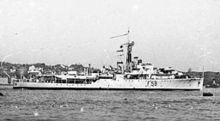Scheer (F 216)
|
||||||||||||||||||||||||||||
|
||||||||||||||||||||||||||||
|
||||||||||||||||||||||||||||
|
||||||||||||||||||||||||||||
The frigate Scheer (F 216) of the German Federal Navy was a training ship of the naval detection school , which was named after the commander of the German deep sea fleet in the Skagerrakschlacht , Admiral Reinhard Scheer (1863-1928).
The ship was launched in 1943 as HMS Hart for the Royal Navy and was in service during World War II . The ship was awarded the Battle Honors Atlantic 1944-45, English Channel 1944, Normandy 1944 and Korea 1951 for its services .
From 1959 to 1967 the Scheer served as a locating training ship for the German Navy. In 1968 it was sold to Hamburg for demolition.
history
The later Scheer was built for the Royal Navy as the sloop HMS Hart at the shipyard Alexander Stephen and Sons in Govan . She was ordered as a modified Black Swan class ship on December 18, 1941, and the keel-laying of the newbuilding No. 595 took place on March 27, 1942. On July 7, 1943 he was launched as the eleventh HMS Hart of the Royal Navy.
On December 12, 1943, the HMS Hart began its service with the "7th Escort Group" in Greenock . In February 1944 she moved with the group to Gibraltar. She returned in May to be available to secure the transports to the invasion area. After a lay in the shipyard, she began her service with the "22nd Escort Group" in December 1944 to protect merchant shipping from German submarines in the Irish Sea and the north-western approaches to the British Isles.
After an overhaul, the transfer of the Hart began in June 1945 in the Pacific through the Mediterranean and across the Indian Ocean and Australia. Via the base of the British Pacific Fleet on Manus ( Admiralty Islands ), the Hart reached Rabaul on September 6, 1945 with the light carrier Glory , the sloop Amethyst , the Australian destroyer Vendetta and smaller units of the RAN . On board the Glory , the Japanese commander Imamura surrendered to the Australian General Sturdee for the Japanese forces in the Bismarck Archipelago and on the Solomon Islands.
The ship stayed with the British Far East Fleet until 1951 and was one of the first units of the UN forces off Korea in June 1950. After the first deployment until August 1950, including artillery support together with the Jamaica , a second deployment followed in the spring of 1951. After returning from the Far East, the ship came to the reserve in Plymouth . Before it was sold to the German Navy, the Hart, like all units intended for sale, was overhauled in Great Britain.
Service as a tracking training ship of the German Navy
Germany acquired the HMS Hart as part of the rearmament of the Federal Republic of Germany from the United Kingdom with six other ships of different classes for use as school frigates. She was one of three frigates of the modified Black Swan class . For the sake of simplicity, the school frigates were grouped under the heading "School frigates class 138 " , although they were by no means all identical, as three escort destroyers of the type Hunt II and III were taken over in addition to the sloops . The Scheer (F216) was put into service on May 21, 1959 in Bremerhaven for the naval location school . The German armored ship Admiral Scheer (1934–1945) of the Germany class was named after Reinhard Scheer . The armament of the frigate was completely removed in 1959. During her service, she undertook several training trips in European waters from Tromsø in the north via Cork in the west to Gibraltar in the south.
From September 1961 to November 30, 1962, the Scheer was rebuilt at the Seebeck shipyard and received the radar systems intended for the new buildings of the German Navy at the time, as well as devices and antennas that were only available on this ship in the Bundeswehr. There were also two 40 mm Bofors L / 70 twin guns fore and aft. In November 1963 she reached the southernmost point of her service while visiting Funchal (Madeira). In October 1966 Gibraltar was visited again. Scheer retired from active service on November 30, 1967. After the disarmament and the cannibalization of the ship, the frigate was sold to Hamburg in 1971 to be scrapped there.
Individual evidence
- ^ Rohwer: Chronicle of the naval war. P. 570.
- ↑ a b c d Hildebrand: School frigate Scheer. Vol. V, p. 102f.
literature
- Hans H. Hildebrand / Albert Röhr, Hans-Otto Steinmetz: The German warships: Biographies - a mirror of naval history from 1815 to the present. Koehlers Verlagsgesellschaft, Herford.
- Günter Kroschel, Klaus-Jürgen Steindorff: The German Navy 1955–1985, ships and aircraft. Lohse-Eissing, Wilhelmshaven 1985, ISBN 3-920602-30-7 .
Web links
- Private homepage about the school frigate Scheer
- Service history HMS HART
- HMS Hart (U 58)
- Thomas Menzel: The seven school frigates (class 138) of the German Navy

